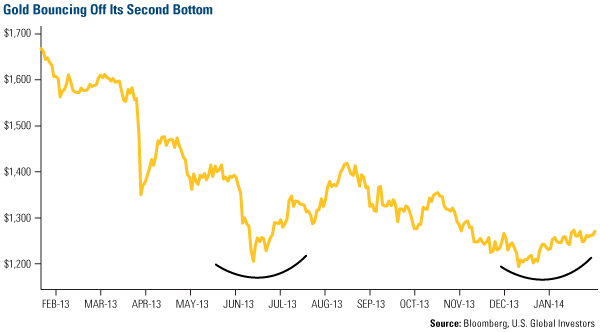Gold Market Radar (February 10, 2014)
For the week, spot gold closed at $1,267.21, up $22.66 per ounce, or 1.82 percent. Gold stocks, as measured by the NYSE Arca Gold Miners Index, rose 1.97 percent. The U.S. Trade-Weighted Dollar Index lost 0.78 percent for the week.
Strengths
- Australia’s Perth Mint, which refines most of the bullion from the world’s second-largest producer, joined the U.S. in reporting that gold demand climbed in January. A Bloomberg story reports sales of coins and minted bars increased 10 percent to 64,818 ounces in January. Sales of gold coins by the U.S. Mint climbed 63 percent in January.
- On the back of last week’s three bought deals, the activity kept up this week as Luna Gold announced a C$20 million bought deal and Gold Standard Ventures announced a C$10 million marketed private placement. In addition, on the M&A front, Silver Standard Resources agreed to purchase the Marigold Mine from Barrick and Goldcorp for $275 million in cash.
- Comstock Mining announced that it secured over 300 acres of private lands adjacent to the American Flat processing area, providing valuable expansion opportunities for its leaching, processing and refining solutions. In addition, the company received notice of the Lyon County Board of Commissioners unanimous approval of zoning law changes expected to increase the company’s reserves dramatically as its Marble, Alhambra and Kossuth mining claims reside in the area.
Weaknesses
- Harmony Gold Mining, the South African miner, announced that a number of its workers died as a rock fall accident triggered a blaze more than one mile underground at its Doorknop site. Search and rescue efforts were deployed, but the efforts were hampered by smog and falling rock. This is South Africa’s worst gold mining accident in at least five-and-a-half years.
- New Gold released its full-year 2013 operating results together with its guidance for 2014. Gold production for 2014 disappointed investors’ expectations at 380 to 420,000 ounces, roughly flat relative to 2013. The analysts at Paradigm Capital were “baffled” as to why the company made no mention of significant reserve grade decreases in the New Afton mine, which represents more than half of the company’s valuation. The team at Desjardins estimates reserve grades across the company decreased 2.9 percent, with New Afton’s grades decreasing nearly 14 percent. As a result, gold contained in the resource statement decreased over 10 percent (ex-Blackwater).
- A Mineweb article suggests that gold ETFs appear to have fallen out of favor in India. The exchange traded funds had their first yearly decline in assets under management (AUM) since their introduction in 2007. In 2013, the local gold ETFs slid 26 percent, losing approximately $479 million in AUM.
Opportunities
- There have been commentaries circulating that suggest billions of dollars worth of private capital is currently waiting to be deployed in the mining sector. Yet, according to Mark Tyler, senior investment banker at Nedbank Capital, there is a “wall of funding” waiting. According to Tyler, there is evidence suggesting $8 billion of private capital, and a similar amount of money in public funds, are currently stuck as fund managers are engaging in more comprehensive due diligence processes. The main argument for the increase is the fact that good deposits have been ruined by poor management in the past, and it takes longer to perform due diligence on management.
- Mexican pension funds have shown fresh interest in gold after certain investment regulations were lifted, says the World Gold Council. The Council has been in contact with fund managers representing nearly $160 billion in assets, who have demonstrated interest in gold investments now that Mexican legislation allows pension funds to invest in gold and commodities.
- West Kirkland Mining, a Nevada gold exploration company, is in the process of acquiring the Hasbrouck asset from Allied Nevada. Tyron Breytenbach at Cormark Securities published a very interesting report in which he remodeled the Hasbrouck project as a smaller, higher grade, heap leach project which West Kirkland could develop with only $55 million in capital expenditure. The resulting production should come at all-in prices below $800 per ounce, which highlights the potential for this project.
Threats
- National Bank Financial is of the opinion that 2014 gold mining production guidance is likely “to carry a mixed negative bias as the move to ‘profitable ounces’ may not materialize as quickly as investors hope.” This next step of cost-cutting may fall short of expectations, both with respect to magnitude and timing, since the flexibility of mining operations is constrained, according to the bank’s analysts.
- The Bureau of Land Management and the U.S. Forest Service are being accused of inappropriately seeking to list the Sage-grouse as an endangered species, which under current U.S. Mining Law would withdraw an estimated 17 million acres from mining-eligible land. The model has been used in the past: in 1980 the U.S. Fish and Wildlife Service declared the spotted owl as threatened, which resulted in an estimated 5.3 million acres being named conservation areas. As a result, more than 200 mills in the Northwest were forced to close.
- A new Environmental Protection Agency (EPA) report states that nearly 40 percent of total toxic chemical releases came from metals mining in 2012. According to the agency, the extraction and beneficiation of metals generates large amounts of waste, which are not especially amenable to reduction. Tim Crowley, President of the Nevada Mining Association, came out in defense of the sector stating that more than 99 percent of the state’s toxic releases are secured and monitored in engineering facilities and protected from exposure to the surrounding environment, a fact that was not found in the EPA report.















